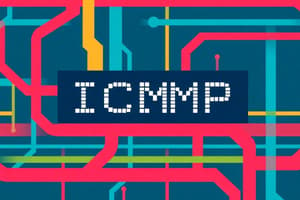Podcast
Questions and Answers
What is the primary function of ICMP in network communication?
What is the primary function of ICMP in network communication?
- To provide feedback about issues processing IP packets (correct)
- To compress data for faster transmission
- To establish secure connections between hosts
- To encrypt data packets in transit
Which message indicates that a destination is unreachable for a sent packet?
Which message indicates that a destination is unreachable for a sent packet?
- ICMP Time Exceeded
- ICMP Echo Reply
- ICMP Destination Unreachable (correct)
- ICMP Echo Request
Which ICMP message confirms that a host is reachable on an IP network?
Which ICMP message confirms that a host is reachable on an IP network?
- ICMP Destination Unreachable
- ICMP Time Exceeded
- ICMP Echo Reply (correct)
- ICMP Echo Request
How does ICMPv6 differ from ICMPv4?
How does ICMPv6 differ from ICMPv4?
Why are ICMPv4 messages often not allowed within a network?
Why are ICMPv4 messages often not allowed within a network?
What is the main purpose of ICMP messages?
What is the main purpose of ICMP messages?
Which of the following commands can be used to test network connectivity?
Which of the following commands can be used to test network connectivity?
What does the Traceroute command primarily accomplish?
What does the Traceroute command primarily accomplish?
Which ICMP message indicates that a destination is unreachable?
Which ICMP message indicates that a destination is unreachable?
What ICMP messages are common to both ICMPv4 and ICMPv6?
What ICMP messages are common to both ICMPv4 and ICMPv6?
What does a successful ping to the loopback address indicate?
What does a successful ping to the loopback address indicate?
Which command is typically used to test connectivity between hosts using ICMP messages?
Which command is typically used to test connectivity between hosts using ICMP messages?
What may cause the first ping to timeout?
What may cause the first ping to timeout?
What does a successful ping to the default gateway imply?
What does a successful ping to the default gateway imply?
If a ping to a remote host fails, which could be a potential reason?
If a ping to a remote host fails, which could be a potential reason?
What is the IPv4 loopback address used for testing internal configuration?
What is the IPv4 loopback address used for testing internal configuration?
What type of messages does the ping command use to test connectivity?
What type of messages does the ping command use to test connectivity?
What indicates that TCP/IP is not operational on a host?
What indicates that TCP/IP is not operational on a host?
What does an RA message provide to a host using SLAAC?
What does an RA message provide to a host using SLAAC?
When a device sends an RS message, what information is it primarily seeking?
When a device sends an RS message, what information is it primarily seeking?
What does DAD stand for, and what is its purpose?
What does DAD stand for, and what is its purpose?
Which message is sent by the device to check if its IPv6 address is unique?
Which message is sent by the device to check if its IPv6 address is unique?
What does the link-local address fe80::1 represent in this context?
What does the link-local address fe80::1 represent in this context?
What protocol is recommended by RFC 4861 in regards to unicast addresses?
What protocol is recommended by RFC 4861 in regards to unicast addresses?
What kind of message will a device respond with if it detects that its IPv6 address is already in use?
What kind of message will a device respond with if it detects that its IPv6 address is already in use?
How does a device find the MAC address of a targeted IPv6 address?
How does a device find the MAC address of a targeted IPv6 address?
What does Traceroute primarily test?
What does Traceroute primarily test?
Which message is generated when a TTL expires in Traceroute?
Which message is generated when a TTL expires in Traceroute?
What is indicated by an asterisk (*) in a Traceroute result?
What is indicated by an asterisk (*) in a Traceroute result?
How does Traceroute determine the address of each hop?
How does Traceroute determine the address of each hop?
What value is the TTL field set to in the first message sent by Traceroute?
What value is the TTL field set to in the first message sent by Traceroute?
Which utility is used to test if hosts can communicate over a network?
Which utility is used to test if hosts can communicate over a network?
What happens when the maximum TTL is reached before reaching the destination in Traceroute?
What happens when the maximum TTL is reached before reaching the destination in Traceroute?
What additional information does Traceroute provide apart from the list of hops?
What additional information does Traceroute provide apart from the list of hops?
Flashcards are hidden until you start studying
Study Notes
ICMP Messages
- The Internet Control Message Protocol (ICMP) provides feedback about issues related to the processing of IP packets.
- ICMPv4 is the messaging protocol for IPv4.
- ICMPv6 is the messaging protocol for IPv6, including additional functionality.
- Common ICMP messages include host reachability, destination or service unreachable, and time exceeded.
- ICMPv4 messages are not necessary and might be blocked in a network for security reasons.
- The ICMP Echo Message can be used to test if a host on an IP network is reachable.
- An ICMP Destination Unreachable message notifies the source of an unreachable destination or service, including a code indicating the reason.
ICMPv6 Messages
- An IPv6-enabled router will send a Router Advertisement (RA) message in response to a Router Solicitation (RS) message.
- A host using Stateless Address Autoconfiguration (SLAAC) will set its default gateway to the link-local address of the router that sent the RA.
- Devices with an assigned global IPv6 unicast or link-local unicast address can perform duplicate address detection (DAD) to ensure the address is unique.
- To verify the uniqueness of an address, a device sends a Neighbor Solicitation (NS) message with its own IPv6 address as the target.
- A device with the same address will reply with a Neighbor Advertisement (NA) message indicating that the address is in use.
- To determine the MAC address of a destination, a device sends an NS message to the solicited node address, including the known IPv6 address.
- The device with the targeted IPv6 address will reply with an NA message containing its Ethernet MAC address.
Ping and Traceroute Tests
- The ping command uses ICMP echo request and echo reply messages to check connectivity between hosts, providing a summary of success rate and average round-trip time.
- Pinging the loopback address (127.0.0.1 for IPv4, ::1 for IPv6) tests the internal configuration of IPv4 or IPv6 on the local host.
- Pinging the default gateway tests a host's ability to communicate on the local network, as the router is normally always operational.
- A successful ping to a remote host confirms communication across an internetwork.
- Network administrators often limit or prohibit ICMP messages, so a lack of ping response might be due to security restrictions.
- Traceroute (tracert) lists the hops that were successfully reached along the path, displaying round-trip time and hop failures marked with an asterisk (*).
- Traceroute leverages the Time to Live (TTL) field in IPv4 and the Hop Limit field in IPv6 combined with the ICMP Time Exceeded message.
- The first traceroute message has a TTL of 1, causing a timeout at the first router, which then responds with an ICMPv4 Time Exceeded message.
- Traceroute increments the TTL field for each sequence of messages, providing hop addresses as packets time out further down the path.
- The TTL field is increased until the destination is reached or it reaches a predefined maximum.
Studying That Suits You
Use AI to generate personalized quizzes and flashcards to suit your learning preferences.




